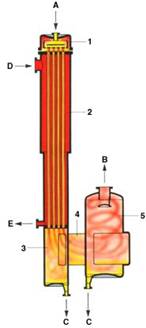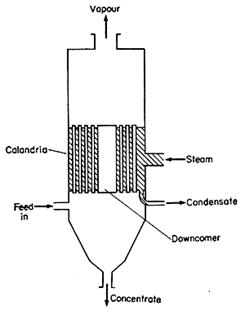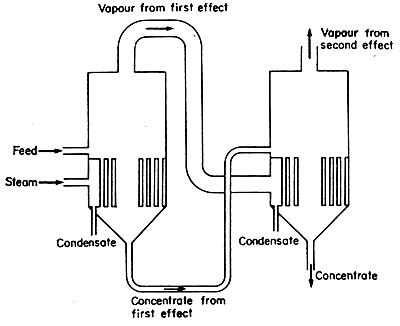AENG 252 :: Lecture 10 :: EVAPORATION – PRINCIPLES, TYPES OF EVAPORATORS
![]()
Evaporation is an operation used to remove a liquid from a solution, suspension, or emulsion by boiling off some of the liquid. It is thus a thermal separation, or thermal concentration, process. We define the evaporation process as one that starts with a liquid product and ends up with a more concentrated, but still liquid and still pumpable concentrate as the main product from the process. There are actually a few instances where the evaporated, volatile component is the main product, but we will not discuss that here.
In most cases it is essential that the product be subject to minimal thermal degradation during the evaporation process, requiring that temperature and time exposure must be minimized. This and other requirements brought on by the physical characteristics of the processed product have resulted in the development of a large range of different evaporator types. Additional demands for energy efficiency and minimized environmental impact have driven development toward very innovative plant configurations and equipment design.
In the field of thermal separation / concentration technology, evaporation plants are widely used for concentration of liquids in the form of solutions, suspensions, and emulsions. The major requirement in the field of evaporation technology is to maintain the quality of the liquid during evaporation and to avoid damage to the product. This may require the liquid to be exposed to the lowest possible boiling temperature for the shortest period of time. This and numerous other requirements and limitations have resulted in a wide variation of designs available today. In almost all evaporators the heating medium is steam, which heats a product on the other side of a heat transfer surface. The following list contains the descriptions of the most common types of evaporators.
- Falling Film Evaporators
- Rising Film Evaporators
- Forced Circulation Evaporators
- Plate Evaporators
- Thermal and Mechanical Vapor Recompression (TVR & MVR)
Typical evaporator applications:
![]() Product concentration
Product concentration
![]() Dryer feed pre-concentration
Dryer feed pre-concentration
![]() Volume reduction
Volume reduction
![]() Water / solvent recovery
Water / solvent recovery
![]() Crystallization
Crystallization
Falling Film Evaporators
In falling film evaporators, liquid and vapors flow downwards in parallel flow. The liquid to be concentrated is preheated to boiling temperature. An even thin film enters the heating tubes via a distribution device in the head of the evaporator, flows downward at boiling temperature, and is partially evaporated. This gravity-induced downward movement is increasingly augmented by the co-current vapor flow.
Falling film evaporators can be operated with very low temperature differences between the heating media and the boiling liquid, and they also have very short product contact times, typically just a few seconds per pass. These characteristics make the falling film evaporator particularly suitable for heat-sensitive products, and it is today the most frequently used type of evaporator.
A: Product B: Vapor C: Concentrate D: Heating Steam E: Condensate |
1: Head |

Fig. 1. Falling Film Evaporator
However, falling film evaporators must be designed very carefully for each operating condition; sufficient wetting of the heating surface by liquid is extremely important for trouble-free operation of the plant. If the heating surfaces are not wetted sufficiently, dry patches and incrustations will occur; at worst, the heating tubes will be completely clogged. In critical cases extending or dividing the evaporator effects, keeping the advantages of single pass operation, can increase the wetting rate. The proper design of the liquid distribution system is critical to achieve full and even product wetting of the tubes. Because of the low liquid holding volume in this type of unit, the falling film evaporator can be started up quickly and changed to cleaning mode or another product easily. Falling film evaporators are highly responsive to alterations of parameters such as energy supply; vacuum, feed rate, concentrations, etc. When equipped with a well-designed automatic control system they can produce a very consistent concentrated product. The fact that falling film evaporators can be operated with small temperature differences makes it possible to use them in multiple effect configurations or with mechanical vapor compression systems in modern plants with very low energy consumption.
Rising Film Evaporators
These operate on a "thermo-siphon" principle. Feed enters the bottom of the heating tubes and as it heats, steam begins to form. The ascending force of this steam produced during the boiling causes liquid and vapors to flow upwards in parallel flow. At the same time the production of vapor increases and the product is pressed as a thin film on the walls of the tubes, and the liquid rises upwards.

A: Product |
Fig.2. Rising Film Evaporator
This co-current upward movement has the beneficial effect of creating a high degree of turbulence in the liquid. This is advantageous during evaporation of highly viscous products and products that have a tendency to foul the heating surfaces. Usually there must be a rather high temperature difference between the heating and boiling sides of this type of evaporator. Otherwise the energy of the vapor flow is not sufficient to convey the liquid and to produce the rising film. The length of the boiling tubes will typically not exceed 23 ft. This type of evaporator is often used with product recirculation, where some of the formed concentrate is reintroduced back to the feed inlet in order to produce sufficient liquid loading inside the boiling tubes.
Forced Circulation Evaporator
Forced circulation evaporators are used if boiling of the product on the heating surfaces is to be avoided due to the fouling characteristics of the product, or to avoid crystallization. The flow velocity in the tubes must be high, and high-capacity pumps are required. The circulating liquid is heated when it flows through the heat exchanger and then partially evaporated when the pressure is reduced in the separator, cooling the liquid to the boiling temperature corresponding to this pressure.

A: Product B: Vapor C: Concentrate D: Heating System E: Condensate |
1: Calandria |
Fig. 3. Forced Circulation Evaporator
The liquid is typically heated only a few degrees for each pass through the heat exchanger, which means the recirculation flow rate has to be high. This type of evaporator is also used in crystallizing applications because no evaporation, and therefore no concentration increase, takes place on the heat transfer surface. Evaporation occurs as the liquid is flash evaporated in the separator/flash vessel. In crystallizer applications this is then where the crystals form, and special separator designs are used to separate crystals from the recirculated crystal slurry. The heat exchanger (in evaporator parlance sometimes called the "calandria") can be arranged either horizontally or vertically depending on the specific requirements in each case.
Methods of Operation of Evaporators
- Single-effect evaporators
A simplified diagram of a single-stage or single-effect evaporator is given in
Fig.1. The feed enters at TF K and saturated steam at Ts enters the heat-exchange section. Condensed steam leaves as condensate or drips. Since the solution in the evaporator is assumed to be completely mixed, the concentrated product and the solution in the evaporator have the same composition and temperature Tt, which is the boiling point of the solution. The temperature of the vapor is also Tt, since it is in equilibrium with the boiling solution. The pressure is P1, which is the vapor pressure of the solution at Tt.
If the solution to be evaporated is assumed to be dilute and like water, then 1 kg of steam condensing will evaporate approximately 1 kg of vapor. This will hold if the feed entering has a temperature TF near the boiling point.
The concept of an overall heat-transfer coefficient is used in the calculation of the rate of heat transfer in an evaporator. The general equation can be written
![]() (1)
(1)
where q is the rate of heat transfer in W, U is the overall heat-transfer coefficient in W/m2. K, A is the heat-transfer area in m2, Tsk is the temperature of the condensing steam in K, and Tl is the boiling point of the liquid in K.

Single-effect evaporators are often used when the required capacity of operation is relatively small and/or the cost of steam is relatively cheap compared to the evaporator cost. However, for large-capacity operation, using more than one effect will markedly reduce steam costs.
2. Forward-feed multiple-effect evaporators
A single-effect evaporator as shown in Fig.1 is wasteful of energy since the latent heat of the vapor leaving is not used but is discarded. However, much of this latent heat can be recovered and reused by employing multiple-effect evaporators. A simplified diagram of a forward-feed triple-effect evaporation system is shown in Fig.2. If the feed to the first effect is near the boiling point at the pressure in the first effect 1 kg of steam will evaporate almost 1 kg of water. The first effect operates at a high-enough temperature so that the evaporated water serves as the heating medium to the second effect. Here, again, almost another kg of water is evaporated, which can be used as the heating medium to the third effect. As a very rough approximation, almost 3 kg of water will be evaporated for 1 kg of steam for a three-effect evaporator. Hence, the steam economy, which is kg vapor evaporated/kg steam used, is increased. This also approximately holds for a number of effects over three. However, this increased steam economy of a multiple-effect evaporator is gained at the expense of the original first cost of these evaporators.

Fig 2. Double effect evaporator – forward feed
In forward-feed operation as shown in Fig.2, the fresh feed is added to the first effect and flows to the next in the same direction as the vapor flow. This method of operation is used when the feed is hot or when the final concentrated product might be damaged at high temperatures. The boiling temperatures decrease from effect to effect. This means that if the first effect is at P1= 1 atm abs pressure, the last effect will be under vacuum at a pressure P3.
In the backward-feed operation shown in Fig.3 for a triple-effect evaporator, the fresh feed enters the last and coldest effect and continues on until the concentrated product leaves the first effect. This method of reverse feed is advantageous when the fresh feed is cold, since a smaller amount of liquid must be heated to the higher temperatures in the second and first effects. However, liquid pumps are used in each effect, since the flow is from low to high pressure. This method is also used when the concentrated product is highly viscous. The high temperatures in the early effects reduce the viscosity and give reasonable heat-transfer coefficients.
4. Parallel-feed multiple-effect evaporators
Parallel feed in multiple-effect evaporators involves the adding of fresh feed and the withdrawal of concentrated product from each effect. The vapor from each effect is still used to heat the next effect. This method of operation is mainly used when the feed is almost saturated and solid crystals are the product, as in the evaporation of brine to make salt.
| Download this lecture as PDF here |
![]()